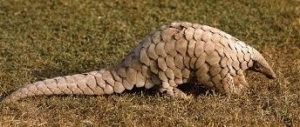About the Species: They are scaly anteater mammals of the order Pholidota.
 Conservation Status:
Conservation Status:
 Conservation Status:
Conservation Status:- IUCN Status: Endangered (India- Endangered, Chinese Pangolin- Critically Endangered)
- Wildlife Protection Act,1972: Under Schedule I of WPA, 1972
Habitat: Out of the eight species of pangolin, the Indian Pangolin and the Chinese Pangolin are found in India:
Indian Pangolin:
- Indian Pangolin is a large anteater covered by 11-13 rows of scales on the back. A terminal scale is also present on the lower side of the tail of the Indian Pangolin, which is absent in the Chinese Pangolin.
- The species is found in various types of tropical forests as well as open land, grasslands, and degraded habitats, including in close proximity to villages.
- Indian Pangolin is widely distributed in India, except the arid region, high Himalayas and the North-East. It can be found at elevation up to 2500 m. The species also occurs in Bangladesh, Pakistan, Nepal and Sri Lanka.
Chinese Pangolin:
- It is found in the Himalayan foothills in Eastern Nepal, Bhutan, Northern India, North-East Bangladesh and through Southern China.
- It is adaptable to a wide range of habitats including primary and secondary tropical forests, limestone and bamboo forests, grasslands, and agricultural fields.
Characteristics:
- They have large, protective keratin scales covering their skin and they are the only known mammals with this feature.
- If under threat, a pangolin will immediately curl into a tight ball and will use their sharp-scaled tails to defend themselves.
- They tend to be solitary animals meeting only to mate and produce a litter of one to three offspring which they raise for about two years.
- Food Habits: They are nocturnal animals and their diet consists of mainly ants and termites which they capture using their long tongues.
Threats:
- Trafficking of live pangolin and its scales is a highly lucrative business for the organized mafia who exploit poor and vulnerable forest-dwelling communities for their criminal interests.
- Hunting and poaching for local consumptive use (e.g. as a protein source and traditional medicine) and international trade, for its meat and scales.
- Heavy Deforestation of their Habitat.




